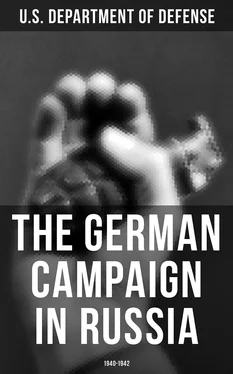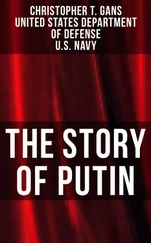The struggle for the forest areas and river courses would dominate the second phase. Since the depth of this zone was 60-120 miles, it would take 2-4 weeks to cross it. At this stage the German forces would either achieve a decisive breakthrough or destroy the previously shattered Russian forces individually.
During the third phase Moscow and Leningrad would have to be seized and the drive into the eastern Ukraine initiated. The distances to be covered were 250 and 200 miles respectively. Whether this phase could be executed immediately after the second would depend upon the condition of the railroads, the serviceability of the track-laying and wheeled vehicles, and the degree of success hitherto achieved. If the Russians were beaten, a few armored or motorized divisions would suffice to keep them off balance, and to seize Moscow and Leningrad and thrust deep into the eastern Ukraine. This would require one or two weeks if sufficient tanks and motor vehicles were available. If, however, the bulk of the Red Army was still capable of offering organized resistance, the start of the third phase would have to be delayed until sufficient supplies were brought up to support the continuation of the offensive. In this case it might be 3-6 weeks, depending on the time needed for the supply buildup.
The fourth and last phase of the offensive would see the Germans pursuing the Russians to the Don, the Volga, and the Severnaya Dvina. The distances to be covered were 250 miles in the south and up to 500 in the center and north. After the Germans had captured Kharkov, Moscow, and Leningrad, the Soviet command would have lost control over its forces but complete occupation of the territory acquired during this phase would be neither possible nor necessary. Motorized forces and rail-transported infantry would be responsible for this operation. The time needed for this phase was estimated at 2-4 weeks.
The total time required to attain the designated objective would therefore vary between a minimum of 9 and a maximum of 17 weeks.
In the event that the Soviet government did not collapse or make peace, the offensive might have to be continued to the Ural Mountains. After the destruction of their armed forces and the loss of their most valuable European territories, the Soviets would probably no longer be capable of conducting military operations but could still set up a government in Asia and maintain a state of war for an indefinite period.
To this plan General Marcks added recommendations for the preparation of the campaign, including details regarding signal communications; the construction and improvement of roads, bridges, railroad facilities, and billeting areas; the organization, equipment, and training of troops; and the procurement of cartographic material.
General Marcks discussed his plan with General der Kavallerie (Lt. Gen.) Ernst Koestring, the German military attaché in Moscow, during the latter's presence at Army High Command headquarters. Koestring did not agree that the seizure of Moscow would be the key to victory. In his opinion the capture of Moscow would not be decisive because the Soviet Union had vast industrial resources beyond the Urals. Moreover, with their ability to improvise, the Russians would be able to reorganize their transportation net without Moscow.
Staff Work
(August-September 1940)
Table of Contents
At the beginning of August the National Defense Division of the Armed Forces High Command completed the directive for AUFBAU OST. It stated that greater military use was to be made of those German-occupied territories of Poland which had not been incorporated into the Reich. The increasing threat of air attacks on western Germany made it imperative to utilize the comparatively safe eastern territories for the activation and training of new units. The necessary accommodations and facilities had to be built; supply depots had to be transferred from west to east; and road, rail, and signal communications had to be improved. The directive was signed by Keitel and issued to all interested military and civilian agencies.
The Army General Staff and technical service divisions were particularly interested in implementing the directive, and a number of organizational measures were initiated by General Halder and his assistants. In September, personnel of the Operations Division under the direction of the new Assistant Chief of Staff, Operations, General-leutnant (Maj. Gen.) Friedrich Paulus, began to work on a strategic survey based on the Marcks plan.
General Jodl had meanwhile asked his subordinates in the National Defense Division to prepare a campaign plan for his own information. This study was to be drawn up without recourse to the plans that were being prepared by the Army, because Jodl wanted to check the Army plans before they were submitted to Hitler. The National Defense Division plan, submitted to Jodl on 19 September, stressed the need for concentrating the attack forces north of the Pripyat Marshes so that they could take the shortest route to Moscow via Smolensk. Three army groups were to be employed; after Army Group Center had seized the Smolensk area, the continuation of the offensive was to depend upon the progress made by Army Group North. If the latter proved to be sufficiently strong to sustain the drive on Leningrad, Army Group Center would employ all its forces on the continuation of its thrust on Moscow. In the event, however, that Army Group North should be unable to make satisfactory progress, Army Group Center would have to halt its advance and divert forces to lend assistance.
In the Finnish Theater of Operations the National Defense planners wanted to concentrate all available German and Finnish forces in the south; no attack in the direction of Murmansk was contemplated. The thrust from southern Finland was to be coordinated with the advance of Army Group North and was to be directed across the Karelian Isthmus toward Leningrad or from east of Lake Lodoga toward Tikhvin.
The strategic survey then being prepared by the Operations Division of the Army probably influenced the National Defense Division plan because of the close relationship between the Armed Forces and Army High Command personnel on the operating level.
Admiral Raeder's Suggestions
(26 September 1940)
Table of Contents
On 26 September the Commander in Chief of the Navy, Adm. Erich Reader, suggested to Hitler that Germany should support the Italian attempt to seize the Suez Canal, whose possession would be vital for a farther advance across Palestine and Syria. Once this had been achieved, Turkey would be at Germany's mercy. The Russian problem would then have an entirely different aspect, since the Soviet Union was basically afraid of Germany. Under such circumstances it would be doubtful whether an invasion of Russia from the north would still be necessary.
In expressing his approval of Raeder's ideas, Hitler stated that Russia would have to be tempted to turn toward Persia and India, where she could gain access to the open sea. That would be far more important to Russia than her position in the Baltic. Hitler, also, was of the opinion that the Soviet Union was apprehensive of Germany's power.
Strategic Survey
(October 1940)
Table of Contents
During October 1940 the Operations Division completed the preparation of a strategic survey which was submitted to General Halder on 29 October. In this study the Army General Staff formulated its own ideas regarding the most appropriate strategy for a campaign against the Soviet Union. The authors of the study realized that the Red Army's numerical strength, the vast terrain to be covered, the adverse conditions of the Russian theater, and the necessity of defeating the Soviet Union with a minimum of delay raised a series of problems for which in many instances no fully satisfactory solutions could be found. On the other hand, ever since the Red Army had performed so badly during the campaign against Finland in the winter of 1939-40, the average German General Staff officer had a low opinion of the military potential of the Soviet Union. Moreover, it was generally assumed that the people in areas recently occupied by the Soviet Union were anti-Russian and anti-Communist, and that disaffection in the Ukraine, the Crimea, and the Caucasus was equally widespread. The purges of 1937 were considered as evidence of the vulnerability of the Soviet Union.
Читать дальше












